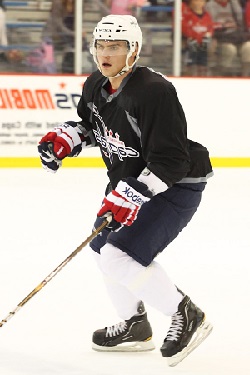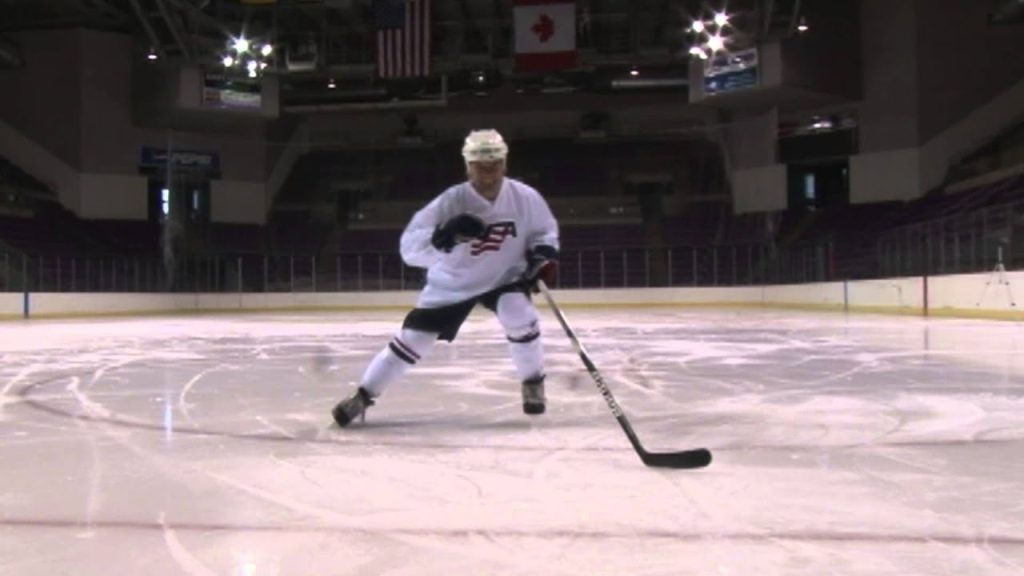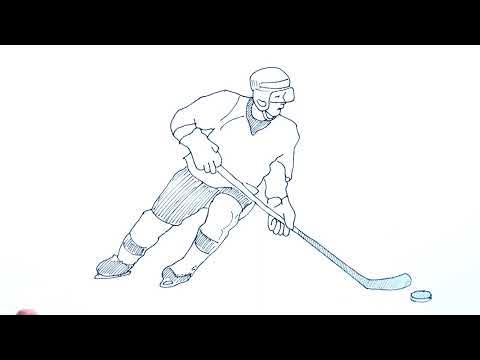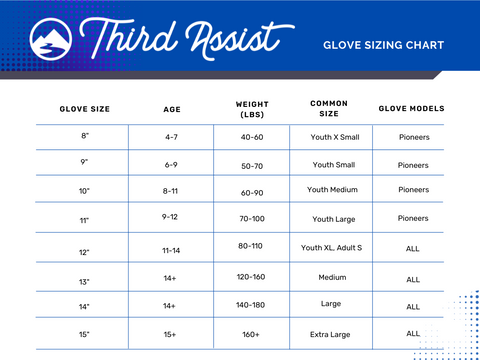Skating backwards is essential in ice hockey. It boosts your agility and control.
Mastering this skill can transform your game. It allows you to keep an eye on the puck and your opponents. You can defend better, react faster, and move strategically. Whether you’re new to ice hockey or looking to improve, learning to skate backwards is crucial.
This guide will help you understand the basics. You’ll learn techniques and tips to practice. Soon, you’ll gain confidence and improve your performance on the ice. Ready to take your skills up a notch? Let’s dive into the steps of skating backwards in ice hockey.

Credit: howtohockey.com
Introduction To Backwards Skating
Backwards skating is a crucial skill in ice hockey. It helps players stay agile and responsive. This skill improves overall game performance.
Learning to skate backwards may seem challenging. With practice, it becomes second nature. Let’s explore why it is important and common challenges faced.
Importance In Ice Hockey
Backwards skating is essential for defense players. It allows them to maintain a strong position while observing the opposing team’s moves. Forwards also benefit from this skill. It helps them quickly change direction and keep up with fast-paced plays.
Here are some key points:
- Improves defensive strategies
- Enhances agility and speed
- Boosts overall game performance
A player’s ability to skate backwards can be a game-changer. It adds an extra layer of strategy and control.
Common Challenges
Many players find backwards skating difficult at first. The most common challenges include:
- Maintaining balance
- Coordinating movements
- Building speed
Maintaining balance is crucial. Without it, players can easily fall or lose control. Coordinating movements can also be tricky. Players must move their feet in a smooth, alternating pattern.
Building speed is another hurdle. Backwards skating requires strong leg muscles and practice. Slow, controlled practice helps overcome these challenges.
| Challenge | Solution |
|---|---|
| Maintaining balance | Practice balance drills |
| Coordinating movements | Focus on smooth, alternating steps |
| Building speed | Gradually increase pace during practice |
Remember, practice and patience are key. Focus on mastering each step. Soon, backwards skating will feel natural.
Essential Gear
Learning how to skate backwards in ice hockey can be challenging. The right gear is crucial for safety and performance. Essential gear includes skates and blades, as well as protective equipment. Let’s dive into what you need.
Skates And Blades
Quality skates make a big difference. Choose skates that fit snugly. They should support your ankles without being too tight. Blades should be sharp and well-maintained. Sharp blades give better control on the ice. Regularly check your blades for any damage. Replace them if they are too worn out.
Protective Equipment
Safety comes first. Wear a helmet with a full face cage. This protects your head and face from injuries. Padded gloves protect your hands and wrists. Knee and elbow pads are also essential. They cushion your joints during falls. A padded shirt or chest protector shields your upper body. Lastly, don’t forget to wear a mouthguard. It protects your teeth and reduces the risk of concussions.
Body Positioning
Effective body positioning is vital for skating backwards in ice hockey. The right posture and placement of your knees and hips can make a big difference. Let’s dive into the details.
Posture Basics
Start with a balanced stance. Keep your feet shoulder-width apart. Bend your knees slightly. Your weight should be centered over the balls of your feet. Lean forward a bit at the waist. This helps maintain balance and control.
Keep your back straight. Avoid hunching over. This will help you see the ice better. Your head should be up. Look over your shoulder in the direction you are skating. This keeps you aware of your surroundings.
Knee And Hip Placement
Your knees should be bent. This lowers your center of gravity. It also helps absorb shocks and bumps. Keep your hips low. This will give you more power in your strides.
Focus on a slight forward lean at your hips. This helps in maintaining balance. Your hips should face the direction you’re moving. This helps in smooth transitions and faster speed.
| Element | Correct Position |
|---|---|
| Feet | Shoulder-width apart |
| Knees | Slightly bent |
| Back | Straight |
| Head | Up, looking over shoulder |
| Hips | Low, facing direction of movement |
Remember, practice makes perfect. Keep working on your body positioning to improve your backward skating skills. Good luck!
Starting Techniques
Learning to skate backwards in ice hockey can seem challenging. But with the right techniques, it becomes much easier. In this section, we’ll cover the starting techniques you need. These will help you get comfortable and improve your backward skating skills.
Initial Push-off
Start by standing with your feet shoulder-width apart. Keep your knees slightly bent. This helps with balance. To push off, angle one skate outward. Then, push firmly against the ice. Use your other skate to maintain balance. Repeat this action to gain momentum.
Glide And Balance
After the initial push-off, it’s important to glide. Let your skates move smoothly over the ice. Keep your body relaxed. Your knees should stay bent. This helps maintain balance. Look over your shoulder to see where you’re going. Avoid looking down at your skates.
Practice gliding in a straight line. This builds confidence. It also improves your balance. Once you feel stable, try alternating feet. Push off with one foot, glide, then switch to the other foot.
Stride And Crossover
Learning how to skate backwards in ice hockey is crucial for any player. A strong backward stride and effective crossovers can set you apart on the ice. These skills are essential for defensemen and forwards alike. This section will guide you through the proper techniques for both.
Proper Stride Technique
Proper stride technique is the foundation of skating backwards. To start, position your feet shoulder-width apart. Bend your knees slightly and keep your back straight. This stance gives you balance and control.
Push off with one foot, extending your leg fully. Your other foot should glide smoothly on the ice. Alternate your feet in a rhythmic motion. Keep your movements steady and controlled.
Here’s a simple table to help you understand the key points:
| Step | Action |
|---|---|
| 1 | Feet shoulder-width apart |
| 2 | Bend knees slightly |
| 3 | Keep back straight |
| 4 | Push off with one foot |
| 5 | Alternate feet rhythmically |
Remember to keep your head up and eyes forward. This helps maintain your balance and awareness of your surroundings.
Effective Crossovers
Effective crossovers are vital for changing direction quickly while skating backwards. Start in the basic backward stride position. Shift your weight to one leg.
Cross the other leg over, placing it firmly on the ice. Push off with the outside edge of the crossover foot. This propels you in the new direction.
Practice these steps to improve your crossovers:
- Shift weight to one leg
- Cross the other leg over
- Place it firmly on the ice
- Push off with the outside edge
- Continue alternating legs
Keep your upper body stable and your arms close to your body. This helps maintain balance and control during the crossover.
Combining a proper stride technique with effective crossovers will enhance your backward skating skills. Practice regularly to build confidence and improve performance on the ice.

Credit: www.wikihow.com
Improving Speed And Control
Improving your speed and control while skating backward in ice hockey is crucial. These skills help you maintain balance and respond quickly. Practicing regularly will enhance your performance on the ice.
Acceleration Drills
Start with basic acceleration drills. Push off with one foot, then the other. Use short, quick strides. Focus on smooth, consistent movements. Gradually increase your pace. Practice stopping and starting. This builds muscle memory and boosts your speed.
Turning And Maneuvering
Turning and maneuvering are essential for backward skating. Begin with gentle turns. Shift your weight to your outside leg. Use your inside leg to guide the turn. Practice figure-eight patterns. This improves your agility. Try tighter turns as you gain confidence. Quick, controlled turns give you an edge in games.
Common Mistakes
Skating backwards in ice hockey is a challenging skill. Many players face common mistakes that hinder their progress. Correcting these mistakes can improve your performance significantly. Let’s explore these common mistakes in detail.
Posture Errors
One frequent mistake is having an incorrect posture. Proper posture is crucial. Without it, you lose balance and control. Players often stand too upright. This makes it hard to shift weight smoothly.
Key points to remember:
- Keep knees bent at all times.
- Lean slightly forward to maintain balance.
- Ensure your back is straight, not hunched.
Incorrect posture leads to inefficient movements. This also increases the risk of falls. Focus on maintaining a low center of gravity. This helps in quick direction changes and better stability.
Stride Issues
Another common mistake involves incorrect stride technique. The stride in backward skating is different from forward skating. Many players push off the wrong edge.
Key points to remember:
- Push off the inside edge of your skate.
- Extend your leg fully during each stride.
- Return to the starting position quickly to maintain speed.
Incorrect striding can lead to slower speeds. It can also cause fatigue quickly. Practice the correct technique to improve your efficiency on the ice. This will help you keep up with the fast pace of the game.
Practice Drills
Learning to skate backwards in ice hockey can be challenging. Practice drills help build confidence and improve skills. Below, we break down some solo and partner drills to help you skate backwards more effectively.
Solo Drills
Solo drills are essential for building individual skills. They allow you to focus on your technique without distractions.
- Backward Glides: Start by pushing off with one foot and gliding backward on the other. Switch feet to balance practice.
- C-Cuts: Make “C” shapes with each foot to gain momentum while moving backward. This helps in maintaining balance and increasing speed.
- Backward Crossovers: Practice crossing one foot over the other while moving backward. This drill improves agility and speed.
- Backward Stops: Practice stopping by digging your heels into the ice. This helps in gaining control and stopping quickly.
Partner Drills
Partner drills add an element of interaction and can be more fun. They help in building communication and team skills.
- Push and Pull: One partner skates backward while the other provides resistance by pushing or pulling. This helps in building strength and coordination.
- Follow the Leader: Skate backward following your partner’s movements. This drill improves reaction time and adaptability.
- Mirror Drill: Stand opposite your partner and mimic their backward skating moves. This helps in building synchronization and awareness.
- Pass and Skate: Practice passing the puck to each other while skating backward. This drill enhances your passing skills and backward skating simultaneously.
Advanced Techniques
Mastering basic backward skating in ice hockey is great. But to truly excel, you need to learn advanced techniques. These skills will help you become more agile and effective on the ice. Below, we will explore two key skills: backward stops and transitioning to forward.
Backward Stops
Learning to stop while skating backward is crucial. It helps you control your speed and position. Here’s how you can do it:
- Get into position: Bend your knees and keep your back straight.
- Use your edges: Shift your weight to the inside edge of one skate and the outside edge of the other.
- Slide to stop: Push outwards with your skates to create friction and stop.
Practice this move slowly at first. As you get comfortable, you can increase your speed. Remember to always keep your knees bent for better balance.
Transitioning To Forward
Transitioning from backward to forward skating is important. It lets you change directions quickly. Here’s a step-by-step guide:
- Prepare: Keep your knees bent and your weight balanced.
- Turn your hips: Rotate your hips towards the direction you want to go.
- Switch edges: Move from the inside edge of your backward skate to the outside edge of your forward skate.
- Push off: Use your back leg to push off and start skating forward.
Practice this transition slowly. Focus on smooth and controlled movements. Over time, you’ll be able to switch directions effortlessly.

Credit: m.youtube.com
Mental Preparation
Learning to skate backwards in ice hockey can be challenging. Mental preparation is key to mastering this skill. With the right mindset, you can overcome fear and improve your performance.
Building Confidence
Confidence is essential in ice hockey. Start by visualizing yourself skating backwards successfully. Picture every detail. See yourself moving smoothly and confidently. Practice this mental image daily.
Set small goals. Celebrate your progress. Each achievement builds confidence. Remember, everyone learns at a different pace. Be patient with yourself.
Staying Focused
Focus is crucial while skating backwards. Keep your mind on your movements. Avoid distractions. Concentrate on your technique. Stay aware of your surroundings on the ice.
Use deep breathing exercises to stay calm. This keeps your mind clear. Helps you focus better. Practice mindfulness. It can improve your concentration during practice sessions.
Frequently Asked Questions
How Do You Start Skating Backwards?
Start by bending your knees slightly. Push off with one foot and glide backward. Alternate feet to maintain momentum.
What Techniques Improve Backward Skating?
Practice the C-cut motion for better balance. Focus on keeping your body low and maintaining a steady rhythm.
How Can I Stop While Skating Backwards?
Use the snowplow stop by angling your skates inward. Apply pressure to slow down gradually.
Why Is Backward Skating Important In Ice Hockey?
Backward skating enhances defensive skills. It allows players to keep an eye on opponents and react quickly.
Conclusion
Skating backwards in ice hockey takes practice and patience. Start with the basics. Work on balance and posture. Keep your knees bent and body relaxed. Practice pushing off with one foot. Use your edges to control speed and direction. Stay focused and consistent.
With time, you will improve. Remember to enjoy the process. Progress comes with dedication. Happy skating!



